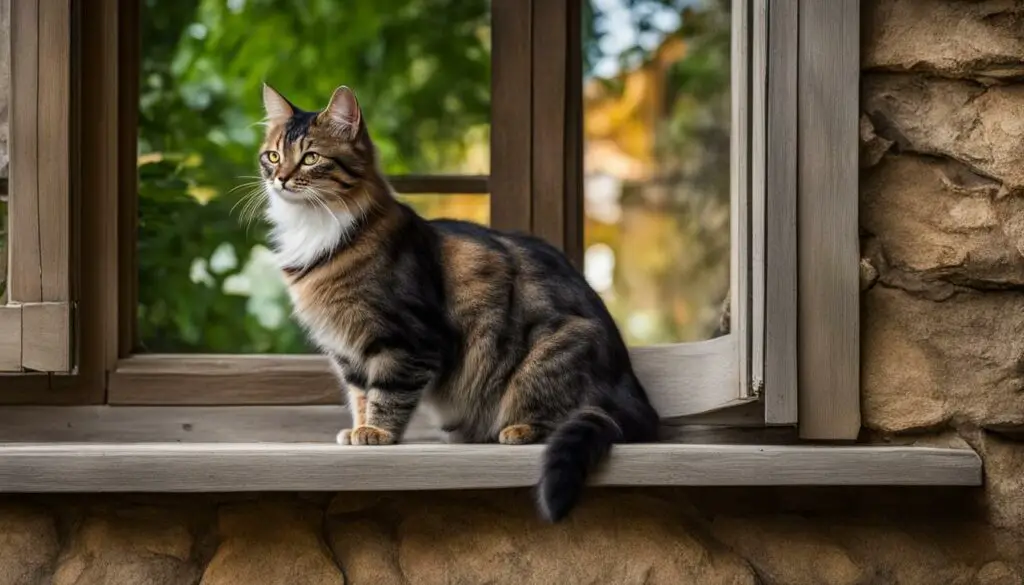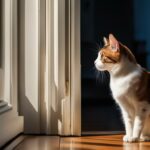As a cat owner, I’ve often wondered why my outdoor cat suddenly wants to stay inside. It’s a common question many of us find ourselves asking. After doing some research and consulting with experts, I’ve discovered there are several reasons behind this behavior. Understanding why your cat wants to be inside is crucial in providing them with a safe and fulfilling indoor life.
Key Takeaways:
- Transitioning an outdoor cat to an indoor life requires patience and gradual changes.
- Providing a cat-friendly indoor environment with scratching posts, litter boxes, and enrichment is essential.
- Make the indoors exciting for your cat by incorporating vertical spaces, interactive toys, and environmental enrichments.
- Spending quality time through play, grooming, and training strengthens the bond between you and your cat.
- Consider providing outdoor access through escape-proof enclosures or cat-proofing balconies.
The Benefits of Keeping Cats Indoors
Keeping cats indoors offers a range of benefits for both their safety and well-being. Indoor cats generally have a longer life expectancy compared to their outdoor counterparts due to the reduced risks they face on a daily basis.
Outdoor cats are exposed to various hazards, including parasites, diseases from other cats, potential accidents such as being hit by cars, theft, and attacks from predators. By keeping your cat inside, you can protect them from these dangers and ensure their safety.
Furthermore, keeping cats indoors also contributes to wildlife conservation efforts. Outdoor cats are natural hunters and can have a significant impact on local bird and small mammal populations. By keeping your cat indoors, you help protect the vulnerable wildlife in your area.
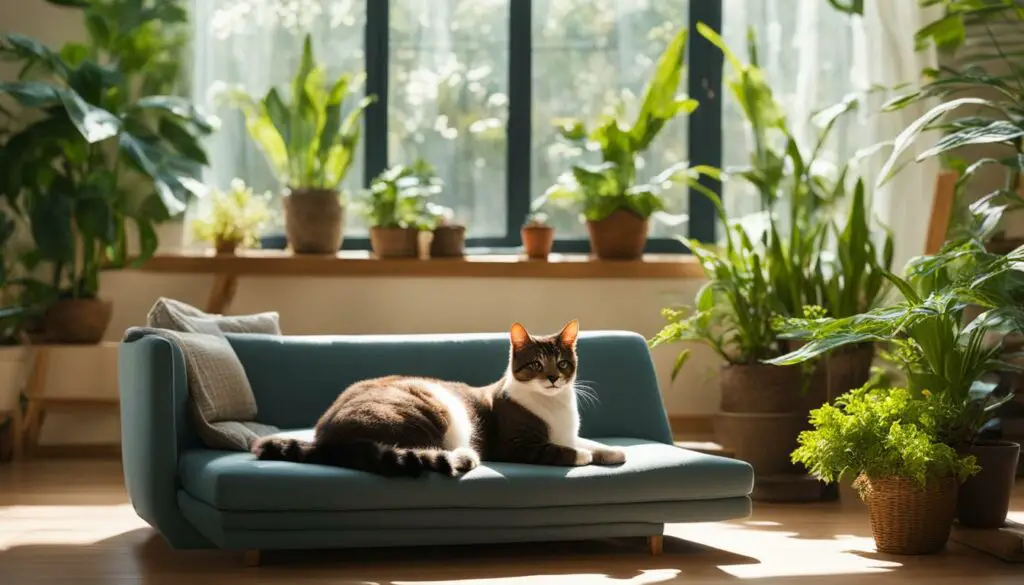
The Benefits of Keeping Cats Indoors
| Benefit | Description |
|---|---|
| Increased Safety | Indoor cats are protected from risks such as accidents, diseases, and attacks from predators. |
| Longer Life Expectancy | Indoor cats generally live longer due to the reduced risks they face outdoors. |
| Wildlife Conservation | Keeping cats indoors helps protect local bird and small mammal populations from hunting. |
When considering whether to keep your cat indoors, it’s important to weigh the benefits and potential downsides. While outdoor cats may enjoy the freedom and stimulation of the outdoors, the risks they face can significantly impact their health and longevity.
By providing a safe and enriching environment indoors, you can ensure that your cat lives a long, happy, and healthy life while also contributing to the conservation of wildlife in your area.
Transitioning an Outdoor Cat to an Indoor Life
Transitioning an outdoor cat to an indoor life requires a gradual approach that takes into account their needs for stimulation and territory. It’s important to provide them with the necessary resources and environmental enrichment to make the transition successful.
One way to facilitate the transition is by introducing scratching posts and litter boxes indoors. These items serve as essential elements for a cat’s natural behaviors and can help them feel more comfortable and engaged in their new indoor environment. Gradually increase their time spent indoors, allowing them to explore and adjust at their own pace.
To ensure their well-being, it’s crucial to provide plenty of stimulation. Interactive toys and playtime sessions can help keep your cat mentally and physically active. Additionally, consider creating vertical spaces, such as cat furniture or shelves, to offer opportunities for climbing and perching. These spaces can mimic the experiences they would have had outdoors.
Remember, every cat is unique, and their preferences may vary. Pay attention to their behavior and adjust the transition process accordingly. By providing a gradual transition, stimulating environment, and understanding their individual needs, you can help your outdoor cat adjust to a safe and fulfilling indoor life.
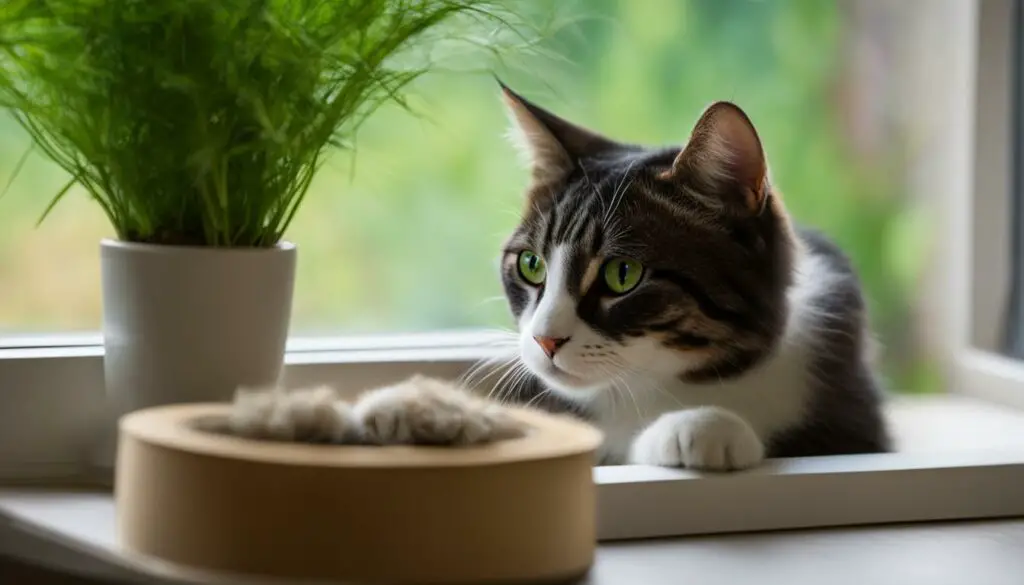
Table: Essential Resources for Transitioning an Outdoor Cat to an Indoor Life
| Resource | Description |
|---|---|
| Scratching Posts | Provide a designated area for your cat to scratch and stretch their muscles, helping to satisfy their natural instincts. |
| Litter Boxes | Offer clean and easily accessible litter boxes to ensure proper toileting habits and maintain a hygienic environment. |
| Interactive Toys | Engage your cat’s hunting instincts and provide mental stimulation with toys that require their participation and provide entertainment. |
| Vertical Spaces | Create climbing and perching opportunities with cat furniture, shelves, or tall scratching towers to mimic the experiences they had outdoors. |
| Playtime Sessions | Set aside dedicated time for interactive play sessions using toys that encourage movement and exercise. |
Creating a Cat-Friendly Indoor Environment
When it comes to keeping your cat happy and content indoors, creating a cat-friendly environment is crucial. By providing them with the right resources and enriching their surroundings, you can ensure that your cat’s needs are met and that they feel comfortable and secure inside your home.
Prioritizing Resting Places
One important aspect of a cat-friendly indoor environment is providing multiple resting places. Cats love to lounge and sleep in different areas throughout the day, so having cozy spots for them to relax is essential. Consider placing soft beds, blankets, or cat trees in various locations around your home. These resting places should be quiet, away from high-traffic areas, and preferably near windows where your cat can observe their surroundings.
Designating Feeding Areas
In addition to resting places, it’s important to have designated feeding areas for your cat. Cats prefer to eat in a quiet and undisturbed location, so set up a separate space for their food and water bowls. Make sure it’s away from their litter box to maintain proper hygiene. Providing consistent meal times and fresh water will help establish a routine and ensure your cat’s nutritional needs are met.
Creating Toileting Areas
Proper toileting areas are also essential for a cat-friendly indoor environment. Place litter boxes in quiet and easily accessible locations. The general rule is to have one litter box per cat, plus an extra one. Keep them clean by scooping the litter daily and replacing it regularly. Cats are naturally clean animals, and having clean litter boxes will encourage them to use them consistently and avoid accidents.
Offering Scratching Posts
Scratching is a natural behavior for cats that helps them stretch, mark their territory, and keep their claws healthy. To protect your furniture and provide an outlet for their scratching needs, provide sturdy and tall scratching posts or pads. Place them strategically throughout your home, especially in areas where your cat spends a lot of time. Encourage your cat to use the scratching posts by sprinkling them with catnip or using pheromone sprays to attract them.
Environmental Enrichment
In addition to the basic necessities, it’s important to enrich your cat’s environment with toys, interactive games, and opportunities for mental stimulation. Provide a variety of toys that cater to your cat’s preferences, such as interactive puzzle toys, feather wands, or laser pointers. Rotate the toys regularly to keep things interesting. Consider setting up perches by windows so your cat can observe the outside world. You can also introduce compatible animals or engage in playtime with your cat to provide social interaction.
Creating a cat-friendly indoor environment requires careful consideration of your cat’s needs and preferences. By providing comfortable resting places, designated feeding and toileting areas, appropriate scratching posts, and environmental enrichment, you can ensure that your cat feels happy, safe, and fulfilled in their indoor surroundings.
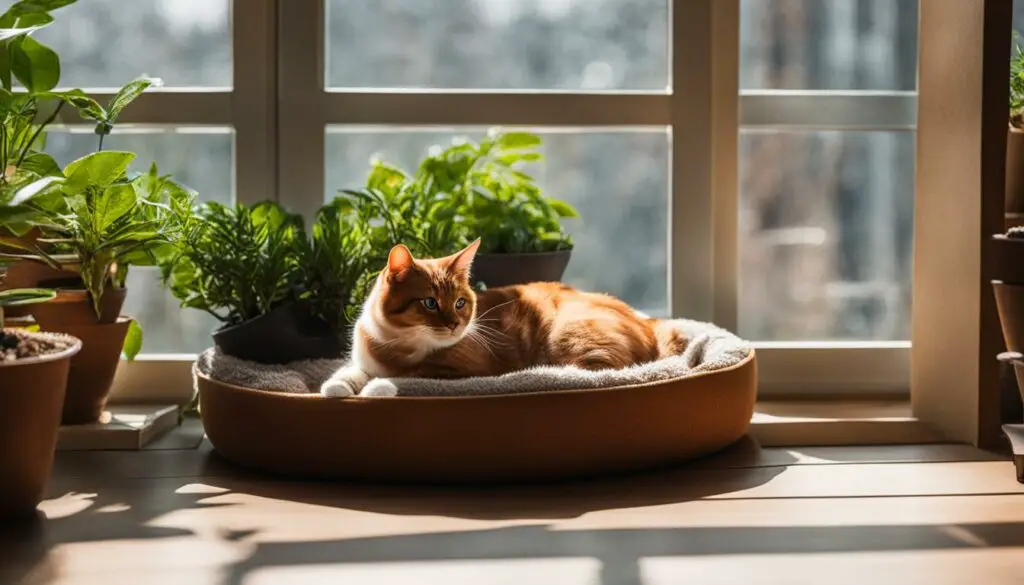
Making the Indoors Exciting for Your Cat
When transitioning an outdoor cat to an indoor life, it’s important to make the indoors as exciting and stimulating as the outdoors. Providing environmental enrichments can help keep your cat mentally and physically engaged. One way to do this is by creating vertical spaces in your home. Install cat furniture, shelves, or tall scratching towers to give your cat the opportunity to climb and explore different heights. This not only provides exercise but also satisfies their natural instinct to be up high and observe their surroundings.
Another great way to make the indoors exciting for your cat is by setting up a catio, an enclosed outdoor space specifically designed for cats. A catio allows your cat to experience the outdoors safely, providing fresh air, stimulation from the sights and sounds of nature, and a change of scenery. It can be as simple as a screened-in porch or as elaborate as a fully enclosed outdoor room with climbing structures and resting areas.
In addition to creating vertical spaces and providing outdoor access, interactive toys can also play a crucial role in keeping your cat entertained indoors. Toys that mimic prey, such as feather wands or puzzle toys that dispense treats, can help satisfy your cat’s hunting instincts. Rotate the toys regularly to keep them interesting and engaging for your feline friend.
| Environmental Enrichments for Indoor Cats | Benefits |
|---|---|
| Vertical spaces (cat furniture, shelves, tall scratching towers) | Opportunity to climb and explore, exercise, and observe surroundings |
| Catios (enclosed outdoor spaces) | Provides fresh air, stimulation from nature, and a change of scenery |
| Interactive toys (feather wands, puzzle toys) | Satisfies hunting instincts, keeps cats mentally engaged |
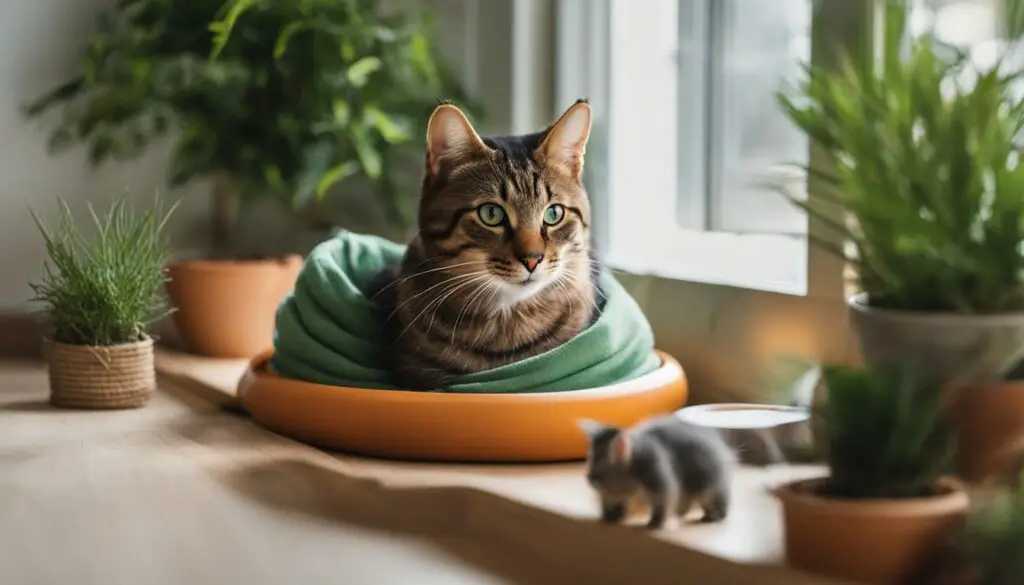
Creating an enriching environment for your indoor cat is essential for their overall well-being. By incorporating vertical spaces, such as cat furniture and scratching towers, along with providing access to outdoor spaces like a catio, you can give your cat opportunities to climb, explore, and experience the outdoors safely. And don’t forget interactive toys that stimulate their hunting instincts and keep them mentally engaged. With these environmental enrichments, your indoor cat can lead a happy and fulfilling life.”
Spending Quality Time with Your Cat
When it comes to keeping your indoor cat happy and content, spending quality time together is essential. Not only does it strengthen the bond between you and your feline companion, but it also provides them with the mental and physical stimulation they need. Here are some ways you can make the most of your time with your cat:
- Playtime: Engage in interactive play sessions with your cat using toys such as feather wands or laser pointers. This helps fulfill their natural hunting instincts and provides exercise for both body and mind.
- Grooming: Regular grooming sessions not only help keep your cat’s coat clean and healthy, but they also serve as bonding moments. Use a soft brush or comb to gently groom your cat, and be sure to give them plenty of praise and affection during the process.
- Training: Cats are intelligent creatures and can be trained to perform simple tricks or tasks using positive reinforcement techniques. Spend time teaching your cat new commands or behaviors, and reward them with treats and praise when they successfully complete the task.
In addition to these activities, showing affection to your cat is crucial. Cuddle with them, pet them, and give them lots of love. Cats thrive on human interaction and will appreciate the attention. Remember to respect your cat’s boundaries and individual preferences, and always make sure the time spent together is enjoyable for both of you.
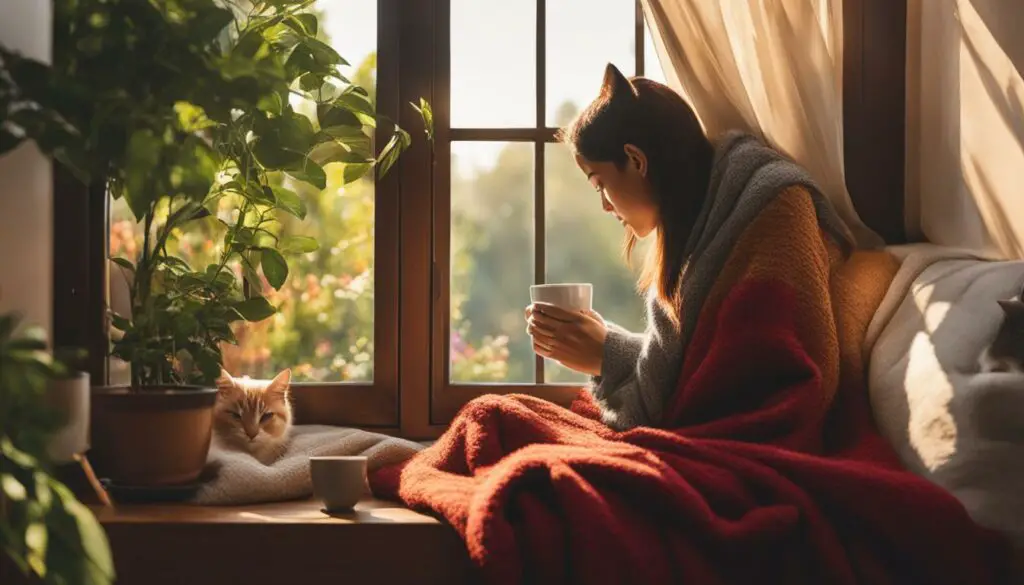
Quote:
“Spending quality time with your cat is not just about fulfilling their physical needs; it’s about nurturing the emotional connection between you and your furry friend.” – Cat Behavior Expert
By dedicating time each day to spend with your cat, you can ensure they receive the attention and care they crave. Whether it’s through play, grooming, training, or simply cuddling, these moments will strengthen the bond between you and create a happy and harmonious living environment for both of you.
Outdoor Access and Alternatives
While keeping your cat indoors is generally recommended, providing some form of outdoor access can be beneficial. Cats have a natural instinct to explore and experience the outdoors, and denying them this opportunity completely may lead to frustration and boredom. However, it is essential to prioritize their safety and minimize potential risks. Here are some alternatives to consider:
- Escape-Proof Enclosures: Constructing an escape-proof enclosure in your backyard or patio can provide a safe outdoor space for your cat. These enclosures, often made with high walls and a secure roof, allow your cat to enjoy the sights, sounds, and fresh air of the outdoors without being exposed to dangers.
- Cat-Proofing Balconies: If you live in an apartment or have a balcony, cat-proofing it is crucial to ensure your cat’s safety. Use sturdy mesh or netting to enclose the area, preventing your cat from accidentally falling or getting stuck.
- Providing Fresh Air: Even without direct access to the outdoors, you can still provide your cat with fresh air by opening windows or installing window screens. This allows them to enjoy the scents and sounds of the outside world while staying safely inside.
Remember, outdoor access should never compromise your cat’s well-being. Ensure that any outdoor space you provide is escape-proof, free from potential hazards, and regularly inspected for wear and tear. Additionally, always supervise your cat during outdoor excursions to prevent encounters with unfamiliar animals or inadvertent escapes. Balancing safety and outdoor exposure can provide a compromise that keeps your indoor cat happy and enriched.
Table: Pros and Cons of Outdoor Access Alternatives
| Outdoor Access Alternatives | Pros | Cons |
|---|---|---|
| Escape-Proof Enclosures | Allows cats to experience the outdoors safely Provides mental stimulation Prevents exposure to outdoor dangers |
Requires space for construction Can be costly May not be suitable for all living situations |
| Cat-Proofing Balconies | Utilizes existing outdoor space Provides fresh air and sensory stimulation Prevents falls or accidents |
Requires installation of secure mesh or netting May not be applicable to all homes or apartments |
| Providing Fresh Air | Allows cats to experience outdoor scents and sounds Easy to implement No additional space required |
Limited physical exploration Minimal exposure to direct sunlight and nature |
In summary, providing outdoor access alternatives for your indoor cat can fulfill their natural instincts while keeping them safe. Whether it’s through escape-proof enclosures, cat-proofed balconies, or simply opening windows, finding a balance between indoor and outdoor experiences will contribute to your cat’s overall well-being and happiness.
Adjusting an Outdoor Cat to Staying at Home
When transitioning an outdoor cat to staying at home, a gradual approach is key to ensure a smooth adjustment. Start by confining your cat indoors for short periods, gradually increasing the amount of time they spend inside. This gradual confinement allows the cat to become accustomed to their new environment and reduces feelings of confinement or anxiety.
During the adjustment period, it’s important to provide distractions and create new hiding and resting areas in the house. This helps to make the indoor environment more appealing and engaging for your cat. Introduce new toys and interactive puzzles to keep them mentally stimulated and entertained. Additionally, provide comfortable resting spots, such as cozy beds or blankets, where your cat can relax and feel secure.
Creating an enriched indoor environment can also help alleviate any stress or boredom your cat may experience. Consider incorporating vertical spaces such as cat trees, shelves, or window perches. These elevated areas allow your cat to observe their surroundings and satisfy their natural climbing instincts. By providing a variety of stimulating experiences within the home, you can help your outdoor cat adjust to staying at home.
| Adjusting an Outdoor Cat to Staying at Home Tips |
|---|
| Gradual Confinement |
| Start by confining your cat indoors for short periods, gradually increasing the amount of time they spend inside. |
| Provide Distractions |
| Introduce new toys and puzzles to keep your cat mentally stimulated and entertained during the transition. |
| Create New Hiding and Resting Areas |
| Make the indoor environment more appealing by creating comfortable hiding spots and cozy resting areas. |
| Enrich the Indoor Environment |
| Incorporate vertical spaces such as cat trees and window perches to satisfy your cat’s natural climbing instincts. |
Remember, every cat is unique, and the adjustment process may vary. Be patient and provide plenty of positive reinforcement and affection during this time. With time and proper care, your outdoor cat can learn to enjoy staying at home and thrive in their new indoor environment.
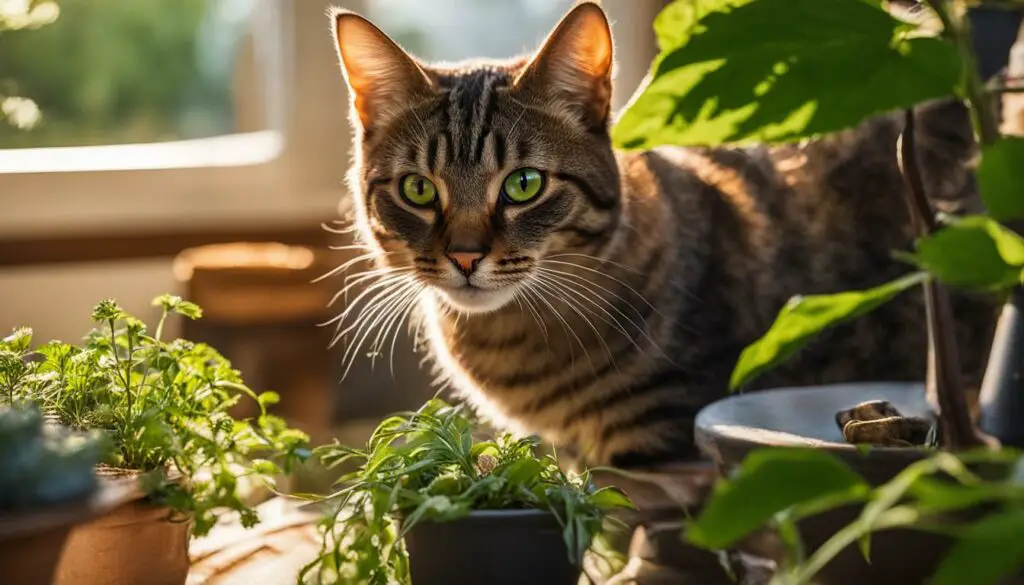
Quote:
“Providing a gradual transition, distractions, and cozy hiding spots can help outdoor cats adjust to staying at home.”
Considering Your Cat’s Individual Preferences
When it comes to cats, each one has their own unique preferences and personality. Some cats may naturally gravitate towards staying indoors, while others may show a strong desire to venture outdoors. It’s important to understand and respect your cat’s individual preferences and provide them with options that cater to their needs.
Cats often establish their own division of territories within the home, even among housemates or siblings. They may prefer specific spaces where they feel most comfortable and secure. This can include favorite resting spots, hiding places, or even certain rooms. Observing and respecting these preferences can help create a harmonious environment for your cat.
It’s also essential to recognize that a cat’s preferences may change over time. Factors such as age, health, and past experiences can influence their desires. What your cat may have enjoyed in the past may no longer appeal to them, or vice versa. Stay attentive to your cat’s behavior and adapt their indoor and outdoor experiences accordingly.
| Cat’s Individual Preferences | Implications |
|---|---|
| Preference for indoor spaces | Ensure a stimulating indoor environment with plenty of enrichment. |
| Preference for outdoor spaces | Provide safe outdoor access through enclosures or supervised outings. |
| Changing preferences | Be adaptable and attentive to your cat’s evolving needs and desires. |
By considering your cat’s individual preferences, you can create a living environment that supports their physical and emotional well-being. Whether your cat prefers the comforts of indoor living or the excitement of outdoor exploration, providing them with options and understanding their changing preferences over time will help them live a happy and fulfilled life.
The Appeal of Outdoor Spaces for Cats
Outdoor spaces hold a unique allure for cats, captivating their senses and providing a wealth of stimulation. From the moment they step outside, cats are greeted with a symphony of sounds – the rustle of leaves, the chirping of birds, and the distant hum of the world around them. These auditory experiences awaken their curiosity and keep them engaged.
The outdoors also offer a rich tapestry of scents, from the earthy aroma of freshly cut grass to the tantalizing fragrance of flowers in bloom. Cats have an exceptional sense of smell, and these olfactory delights add layers of intrigue to their outdoor explorations. The diverse range of smells inspires their hunting instincts and keeps them enthralled.
Moreover, outdoor spaces provide cats with a feast for the eyes. The vibrant colors of nature, the fluttering of butterflies, and the sight of other creatures going about their daily routines create a visual spectacle that evokes their predatory instincts. The dynamic visual experiences offered by the great outdoors entice cats and arouse their natural behaviors.
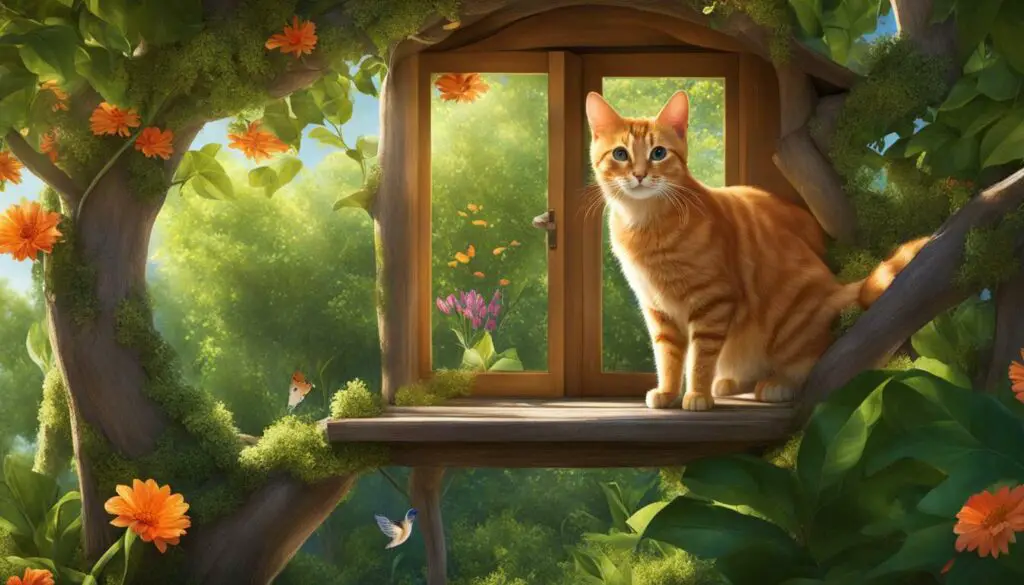
While it’s important to create an enriching indoor environment for your cat, understanding the appeal of outdoor spaces can help you empathize with their desire to venture beyond the confines of your home. By carefully considering their sensory needs and providing stimulating experiences indoors, you can help satisfy their natural instincts while keeping them safe and protected.
Colder Weather and Indoor Preference
As the temperature drops and winter arrives, it’s natural for cats to seek warmth and comfort indoors. The colder weather often leads to a decreased preference for outdoor activities, causing cats to spend more time inside. This change in behavior is a natural response to the chilly conditions and their instinctive need for warmth.
Indoor environments provide cats with a cozy and safe haven during colder seasons. As the mercury drops, they are drawn to the warmth of our homes, seeking out comfortable spots to curl up and stay cozy. This behavior is a reflection of their natural instincts to stay warm and conserve energy during cooler periods.
The decreased outdoor activity during colder weather also reduces the appeal of venturing outside for many cats. The allure of exploring the outdoors may be overshadowed by the desire for a comfortable indoor environment. Cats often prioritize their own well-being and comfort, and the colder weather prompts them to choose the coziness of the indoors.
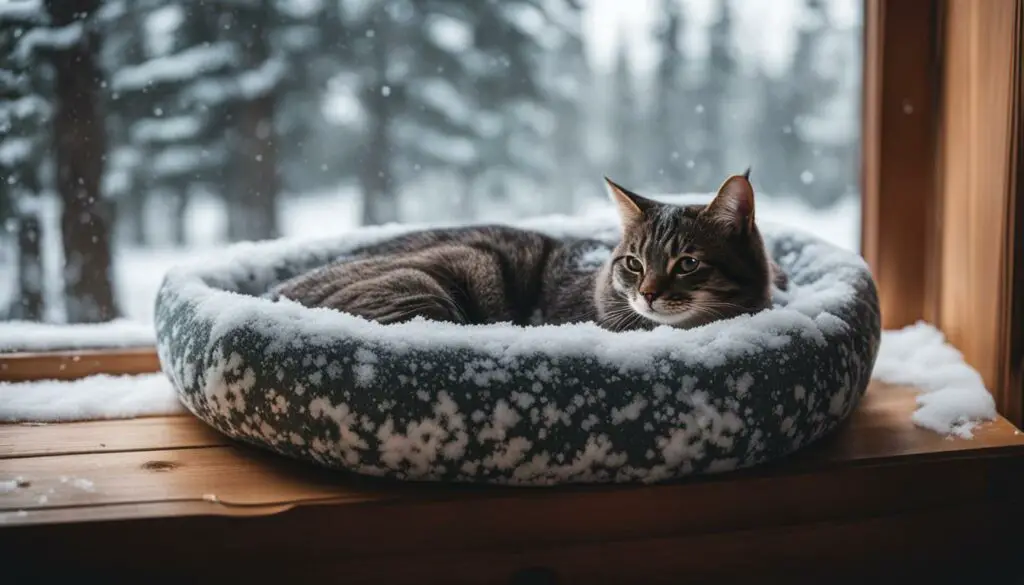
Understanding and respecting your cat’s preference for staying indoors during colder weather is important. By providing them with a warm and inviting indoor environment, you can ensure their comfort and well-being throughout the winter months. Whether it’s creating cozy spots with blankets and heated beds or simply keeping your home at a comfortable temperature, catering to their need for warmth will help them thrive indoors.
| Benefits of Indoor Preference during Colder Weather | Risks of Outdoor Exposure during Colder Weather |
|---|---|
|
|
By understanding your cat’s inclination towards staying indoors during colder weather and providing them with a warm and comfortable environment, you can ensure their well-being and cater to their preferences. Remember to provide plenty of cozy spots, blankets, and other comforting elements to create a pleasant indoor space where they can feel safe and content.
The Role of Companionship in Cat Behavior
Companionship plays a crucial role in shaping a cat’s behavior and overall well-being. Cats are social creatures that thrive on interaction and connection, both with humans and other animals. The bond between a cat and their human companion is often strong, and it can greatly influence the cat’s behavior and happiness.
When cats have a strong bond with their human, they are more likely to feel secure and content. This sense of security can help reduce anxiety and stress, leading to a calmer and more well-adjusted cat. Spending quality time with your cat, such as engaging in playtime, grooming, and providing affection, strengthens the bond between you and your feline friend.
Additionally, providing companionship to outdoor cats can be beneficial. If your cat enjoys spending time in outdoor spaces, consider joining them from time to time. This not only provides valuable attention and interaction but also ensures their safety and well-being. Sitting with your cat in an outdoor enclosure or catio allows them to experience the outdoors while still being protected.
The Cat-Human Bond
The bond between a cat and their human companion is unique and special. Cats can form deep emotional connections with their owners, demonstrating loyalty and affection in their own unique ways. Understanding and nurturing this bond is essential in creating a harmonious and fulfilling relationship with your cat.
“The bond with a cat is a relationship like no other. They have their own personalities, their own ways of expressing love and loyalty. It’s a privilege to be part of that special connection.” – Cat lover
By providing companionship and ensuring your cat feels loved and valued, you can positively influence their behavior and overall happiness. Whether indoors or outdoors, the presence of a caring companion can make a significant difference in a cat’s life.
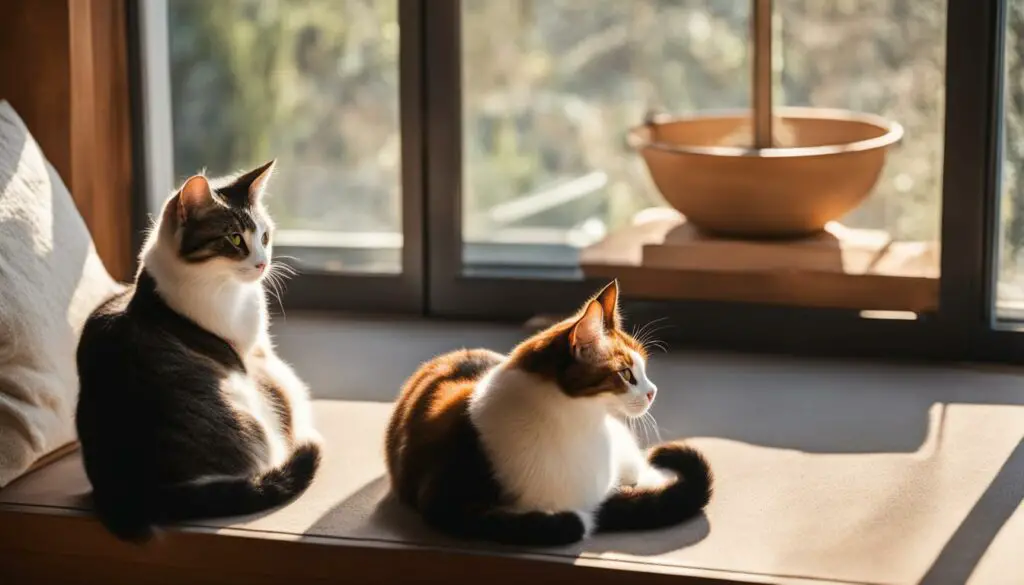
| Benefits of Companionship | Ways to Provide Companionship |
|---|---|
|
|
Conclusion
Throughout this comprehensive guide, I have explored why your outdoor cat wants to stay inside and provided you with valuable insights on transitioning your feline friend to an indoor life. By understanding their behavior and taking appropriate measures, you can ensure their well-being and safety while offering them a fulfilling indoor environment.
Remember, the benefits of keeping cats indoors are numerous. By protecting them from potential dangers such as diseases, accidents, and theft, you can significantly extend their lifespan. Additionally, keeping your cat indoors contributes to wildlife conservation efforts, reducing their impact on local ecosystems.
When transitioning your outdoor cat to an indoor life, take it gradually. Introduce them to essential indoor resources like scratching posts and litter boxes. Provide plenty of stimulation through interactive toys and engage them in playtime and enrichment activities. By making the indoors as exciting as the outdoors, you can help your cat adjust to their new environment.
To create a cat-friendly indoor environment, ensure there are multiple resting places, designated feeding areas, and appropriate toileting areas. Provide scratching posts to satisfy their natural instincts and enrich their environment with toys, perches, and opportunities for interaction with compatible animals and people.
Make the indoors exciting for your cat by implementing environmental enrichments such as vertical spaces, catios, and interactive toys. Spend quality time with your cat through playtime, grooming, training, and showing affection, strengthening the bond between you and your feline companion.
While keeping your cat indoors is generally recommended, providing some form of outdoor access can be beneficial. Consider creating escape-proof enclosures or cat-proofing your balcony. Alternatively, provide access to windows where your cat can enjoy fresh air and observe their surroundings.
If you have an outdoor cat that you’d like to transition to staying at home, do so gradually. Confining them indoors during certain periods and introducing new hiding and resting areas can help them adjust to their new routine.
Each cat has individual preferences, so be attentive to their needs and provide them with options for both indoor and outdoor experiences. Understand the appeal of outdoor spaces for cats, with their sensory stimuli and stimulation. Consider the role of companionship in cat behavior and join your cat in outdoor spaces to strengthen the cat-human bond.
By following this comprehensive guide and adapting to your cat’s individual preferences, you can successfully navigate the transition from outdoor to indoor life. Remember, patience and care are key to ensuring your cat lives a happy and fulfilling life indoors.
FAQ
Why does my outdoor cat suddenly want to stay inside?
There can be several reasons for this behavior, including the desire for safety, protection from risks, and a need for a fulfilling indoor life.
What are the benefits of keeping cats indoors?
Indoor cats have a longer life expectancy, are protected from various dangers such as diseases and predators, and contribute to wildlife conservation efforts.
How do I transition my outdoor cat to an indoor life?
It’s important to make the transition gradually, introducing indoor resources and providing plenty of stimulation and enrichment to make the indoors as engaging as the outdoors.
How can I create a cat-friendly indoor environment?
By providing multiple resting places, designated feeding and toileting areas, and satisfying their natural behaviors with scratching posts and environmental enrichment.
How can I make the indoors exciting for my cat?
You can create vertical spaces, consider installing a catio, provide interactive toys and mental stimulation, and engage in regular playtime sessions and grooming routines.
Should I provide outdoor access for my indoor cat?
Some form of outdoor access, such as an escape-proof enclosure or cat-proofed balcony, can be beneficial, but it’s important to prioritize safety.
How do I adjust my outdoor cat to staying at home?
Gradually confine them indoors, provide distractions and new hiding/resting areas, and make the indoor environment appealing and comfortable.
What should I consider regarding my cat’s individual preferences?
Cats may have changing preferences for indoor and outdoor spaces, so it’s important to observe and provide options that cater to their needs.
Why do cats find outdoor spaces appealing?
The outdoors offer sensory stimulation, such as sounds, smells, and visual experiences, which can be more engaging than the predictable environment indoors.
Why does my cat show less interest in the outdoors during colder weather?
Cats seek warmth and comfort indoors during colder seasons, naturally preferring the cozy environment over outdoor spaces.
How does companionship affect cat behavior?
Cats seek interaction and social connection, so joining your cat in outdoor spaces can strengthen the bond and provide additional attention and companionship.
Source Links
- https://www.kittyhelpdesk.com/help-desk/help-my-cat-wants-to-stay-on-the-catio
- https://www.humanesociety.org/resources/how-bring-outside-cat-indoors
- https://kb.rspca.org.au/knowledge-base/i-want-to-start-keeping-my-cat-safely-at-home-all-of-the-time-how-do-i-adjust-an-outdoor-cat-to-staying-on-my-property/

